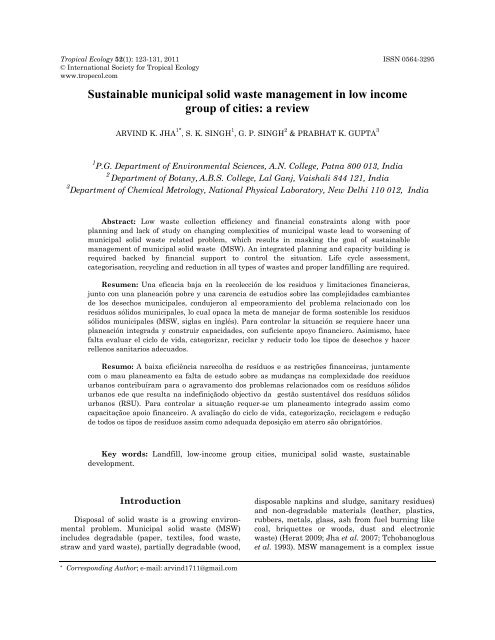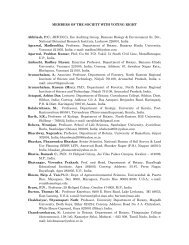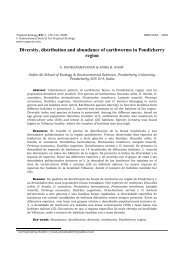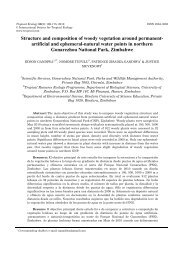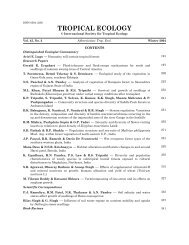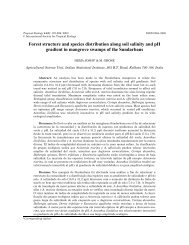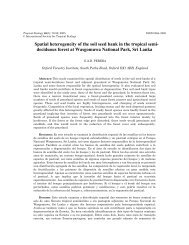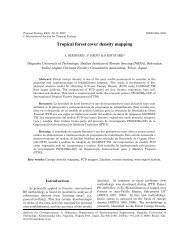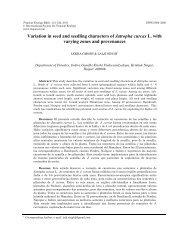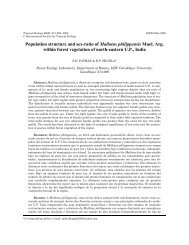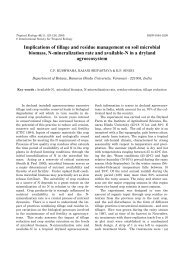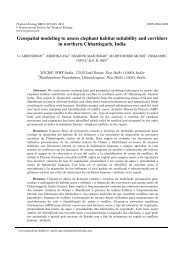Sustainable municipal solid waste management in ... - ResearchGate
Sustainable municipal solid waste management in ... - ResearchGate
Sustainable municipal solid waste management in ... - ResearchGate
Create successful ePaper yourself
Turn your PDF publications into a flip-book with our unique Google optimized e-Paper software.
Tropical Ecology 52(1): 123-131, 2011 ISSN 0564-3295<br />
© International Society for Tropical Ecology<br />
www.tropecol.com<br />
<strong>Susta<strong>in</strong>able</strong> <strong>municipal</strong> <strong>solid</strong> <strong>waste</strong> <strong>management</strong> <strong>in</strong> low <strong>in</strong>come<br />
group of cities: a review<br />
ARVIND K. JHA 1* , S. K. SINGH 1 , G. P. SINGH 2 & PRABHAT K. GUPTA 3<br />
1 P.G. Department of Environmental Sciences, A.N. College, Patna 800 013, India<br />
2<br />
Department of Botany, A.B.S. College, Lal Ganj, Vaishali 844 121, India<br />
3 Department of Chemical Metrology, National Physical Laboratory, New Delhi 110 012, India<br />
Abstract: Low <strong>waste</strong> collection efficiency and f<strong>in</strong>ancial constra<strong>in</strong>ts along with poor<br />
plann<strong>in</strong>g and lack of study on chang<strong>in</strong>g complexities of <strong>municipal</strong> <strong>waste</strong> lead to worsen<strong>in</strong>g of<br />
<strong>municipal</strong> <strong>solid</strong> <strong>waste</strong> related problem, which results <strong>in</strong> mask<strong>in</strong>g the goal of susta<strong>in</strong>able<br />
<strong>management</strong> of <strong>municipal</strong> <strong>solid</strong> <strong>waste</strong> (MSW). An <strong>in</strong>tegrated plann<strong>in</strong>g and capacity build<strong>in</strong>g is<br />
required backed by f<strong>in</strong>ancial support to control the situation. Life cycle assessment,<br />
categorisation, recycl<strong>in</strong>g and reduction <strong>in</strong> all types of <strong>waste</strong>s and proper landfill<strong>in</strong>g are required.<br />
Resumen: Una eficacia baja en la recolección de los residuos y limitaciones f<strong>in</strong>ancieras,<br />
junto con una planeación pobre y una carencia de estudios sobre las complejidades cambiantes<br />
de los desechos <strong>municipal</strong>es, condujeron al empeoramiento del problema relacionado con los<br />
residuos sólidos <strong>municipal</strong>es, lo cual opaca la meta de manejar de forma sostenible los residuos<br />
sólidos <strong>municipal</strong>es (MSW, siglas en <strong>in</strong>glés). Para controlar la situación se requiere hacer una<br />
planeación <strong>in</strong>tegrada y construir capacidades, con suficiente apoyo f<strong>in</strong>anciero. Asimismo, hace<br />
falta evaluar el ciclo de vida, categorizar, reciclar y reducir todo los tipos de desechos y hacer<br />
rellenos sanitarios adecuados.<br />
Resumo: A baixa eficiência narecolha de resíduos e as restrições f<strong>in</strong>anceiras, juntamente<br />
com o mau planeamento ea falta de estudo sobre as mudanças na complexidade dos resíduos<br />
urbanos contribuíram para o agravamento dos problemas relacionados com os resíduos sólidos<br />
urbanos ede que resulta na <strong>in</strong>def<strong>in</strong>içãodo objectivo da gestão sustentável dos resíduos sólidos<br />
urbanos (RSU). Para controlar a situação requer-se um planeamento <strong>in</strong>tegrado assim como<br />
capacitaçãoe apoio f<strong>in</strong>anceiro. A avaliação do ciclo de vida, categorização, reciclagem e redução<br />
de todos os tipos de resíduos assim como adequada deposição em aterro são obrigatórios.<br />
Key words: Landfill, low-<strong>in</strong>come group cities, <strong>municipal</strong> <strong>solid</strong> <strong>waste</strong>, susta<strong>in</strong>able<br />
development.<br />
Introduction<br />
Disposal of <strong>solid</strong> <strong>waste</strong> is a grow<strong>in</strong>g environmental<br />
problem. Municipal <strong>solid</strong> <strong>waste</strong> (MSW)<br />
<strong>in</strong>cludes degradable (paper, textiles, food <strong>waste</strong>,<br />
straw and yard <strong>waste</strong>), partially degradable (wood,<br />
disposable napk<strong>in</strong>s and sludge, sanitary residues)<br />
and non-degradable materials (leather, plastics,<br />
rubbers, metals, glass, ash from fuel burn<strong>in</strong>g like<br />
coal, briquettes or woods, dust and electronic<br />
<strong>waste</strong>) (Herat 2009; Jha et al. 2007; Tchobanoglous<br />
et al. 1993). MSW <strong>management</strong> is a complex issue<br />
* Correspond<strong>in</strong>g Author; e-mail: arv<strong>in</strong>d1711@gmail.com
124 MUNICIPAL SOLID WASTE MANAGEMENT<br />
Table 1. Municipal <strong>solid</strong> <strong>waste</strong> <strong>management</strong> <strong>in</strong> different <strong>in</strong>come group of cities.<br />
Parameters Low-<strong>in</strong>come Middle-<strong>in</strong>come High-<strong>in</strong>come<br />
Per capita <strong>in</strong>come (US $) Less than 2000 2000-15000 More than 15000<br />
MSW generation rate (kg 0.3-0.7 0.5-1.5 > 1.0<br />
capita -1 day -1 )<br />
MSW collection rate (%) < 70 80-95 Nearly 100<br />
Recycl<strong>in</strong>g agent Informal Formal+ Informal Formal<br />
End MSW disposal Open dump Open dump/ susta<strong>in</strong>able<br />
landfill<br />
<strong>Susta<strong>in</strong>able</strong> landfill<br />
Management capacity<br />
status<br />
Plann<strong>in</strong>g<br />
Regulation<br />
Examples<br />
Poor<br />
Lack of plann<strong>in</strong>g / short<br />
term plann<strong>in</strong>g<br />
Lack of regulation or lack<br />
of enforcement<br />
Dhaka, Kathmandu,<br />
Karachi, Phnon Penh,<br />
almost all Indian, most<br />
African and South<br />
American cities<br />
(Mendes & Imura 2004; IPCC 2006; World Bank 2000; OECD 2002)<br />
Need for capacity build<strong>in</strong>g<br />
& f<strong>in</strong>ance<br />
Short to medium term<br />
plann<strong>in</strong>g<br />
Poor enforcement of law<br />
Beij<strong>in</strong>g, Manila, Shanghai,<br />
Kuala Lampur,<br />
Needs more precise<br />
measures<br />
Medium to long term<br />
plann<strong>in</strong>g<br />
Generally well monitored<br />
Tokyo, Taipei, Cities of<br />
USA, UK, etc.<br />
due to chang<strong>in</strong>g lifestyle of people, rapid urbanization,<br />
and under-estimated contributors and<br />
stakeholders (Contreras et al. 2008; Da Zhu et al.<br />
2008). Municipal bodies <strong>in</strong> low-<strong>in</strong>come group of<br />
cities dispose MSW <strong>in</strong> low ly<strong>in</strong>g areas <strong>in</strong> the<br />
outskirt of the city and fill these areas one after<br />
the other haphazardly due to limited knowledge<br />
and awareness regard<strong>in</strong>g contam<strong>in</strong>ation, <strong>waste</strong><br />
reduction techniques and other aspects of MSW<br />
<strong>management</strong> (Da Zhu et al. 2008; Sharholy et al.<br />
2008). We have attempted <strong>in</strong> this article to<br />
exam<strong>in</strong>e traditional practices of MSW <strong>management</strong>,<br />
constra<strong>in</strong>ts towards achiev<strong>in</strong>g susta<strong>in</strong>able<br />
MSW <strong>management</strong> <strong>in</strong> low-<strong>in</strong>come group of cities<br />
and their remedial measures.<br />
Municipal <strong>solid</strong> <strong>waste</strong> <strong>management</strong><br />
MSW <strong>management</strong> encompasses plann<strong>in</strong>g,<br />
eng<strong>in</strong>eer<strong>in</strong>g, organization, adm<strong>in</strong>istration, f<strong>in</strong>ancial<br />
and legal aspects of activities associated with<br />
generation, growth, storage, collection, transport,<br />
process<strong>in</strong>g and disposal <strong>in</strong> an environmentally<br />
compatible manner adopt<strong>in</strong>g pr<strong>in</strong>ciples of<br />
economy, aesthetics, energy and conservation (Tchobanoglous<br />
et al. 1993). Although population growth<br />
and <strong>waste</strong> generation are global challenges, the<br />
condition of low-<strong>in</strong>come cities is of particular<br />
concern. Cities hav<strong>in</strong>g less than $2000, $2000-<br />
$15000 and higher than $15000 per capita <strong>in</strong>come<br />
are categorized as low-<strong>in</strong>come, middle <strong>in</strong>come and<br />
high-<strong>in</strong>come cities (Mendes & Imura 2004). Although<br />
MSW generation rate is high <strong>in</strong> cities of the<br />
developed world, they are well equipped and have<br />
well-surveyed mass and material flow data from<br />
cradle to crest (Table 1), which are unavailable for<br />
low-<strong>in</strong>come cities of the develop<strong>in</strong>g countries.<br />
In low-<strong>in</strong>come group of cities, the exist<strong>in</strong>g practices<br />
of MSW <strong>management</strong> and their plann<strong>in</strong>g are<br />
based on projection of population and per capita<br />
<strong>waste</strong> generation based on sample survey (Khatib<br />
et al. 2007; MOEF 2006; Shimura et al. 2001;<br />
Upadhyay et al. 2005). Comprehensive survey <strong>in</strong><br />
w<strong>in</strong>ter, summer and ra<strong>in</strong>y seasons for each generation<br />
source is unavailable. The seasonal variation<br />
<strong>in</strong> MSW generation is due to the fact that<br />
more biomass is burnt <strong>in</strong> w<strong>in</strong>ter, more scatter<strong>in</strong>g<br />
of MSW takes place <strong>in</strong> summer and more water<br />
soluble organic matters f<strong>in</strong>d way <strong>in</strong> gutters dur<strong>in</strong>g<br />
ra<strong>in</strong>y season. MSW generation also rises dur<strong>in</strong>g<br />
festive seasons that require temporary control<br />
measures. Stakeholders of MSW generation and<br />
<strong>management</strong> need to be considered on case-to-case<br />
basis as MSW <strong>management</strong> issues are specific and<br />
localized. The first group of stakeholders is MSW<br />
generators like households, <strong>in</strong>stitutional areas,<br />
different groups of bus<strong>in</strong>esses; float<strong>in</strong>g populations;<br />
health care services; etc. Second group of stake-
JHA et al. 125<br />
Table 2. Criteria <strong>in</strong>dicators of MSW <strong>management</strong> and their relative importance.<br />
Criteria <strong>in</strong>dicator Driv<strong>in</strong>g force of criteria <strong>in</strong>dicators Relative importance and<br />
their need<br />
Public health * a. Income status, density and awareness of population<br />
b. MSW generation and removal rate<br />
c. MSW composition & quantity and their seasonal variation<br />
d. Rag picker’s status & awareness<br />
e. Contam<strong>in</strong>ation prevention facilities and <strong>in</strong>frastructure<br />
f. Potential and spread of contam<strong>in</strong>ation; contam<strong>in</strong>ation<br />
prevention, etc.<br />
Directly related to control<br />
& prevention of<br />
contam<strong>in</strong>ation; aesthetics<br />
and credibility of the cityneeds<br />
awareness, funds<br />
and personal protection<br />
Environmental<br />
scenario#<br />
Present and<br />
future cost to<br />
society**<br />
a. Influence of social and economic status<br />
b. MSW generation and removal rate<br />
c. Composition and total quantum<br />
d. Resource recovery & recycl<strong>in</strong>g<br />
e. Decomposable matter content<br />
f. Climatic and weather set up<br />
g. Infrastructure for MSW <strong>management</strong><br />
h. Decomposition characteristics of <strong>waste</strong> at <strong>in</strong>termediate<br />
transfer po<strong>in</strong>ts and landfills<br />
i. MSW collection efficiency<br />
j. Leach<strong>in</strong>g, air pollution & greenhouse gas emission<br />
potential<br />
k. Level<strong>in</strong>g, compaction and cover soil provision at landfill<br />
l. Percentage of MSW burn<strong>in</strong>g at landfill, etc.<br />
a. Purchase capacity and awareness among stakeholders<br />
b. Employment <strong>in</strong> formal & <strong>in</strong>formal sectors<br />
c. Cost of MSW <strong>management</strong><br />
d. Composition and quantum<br />
e. Economic activity like recycl<strong>in</strong>g and compost<strong>in</strong>g and<br />
associated market<br />
f. Extent of contam<strong>in</strong>ation and burden on landfill<br />
g. Taxes and duty implications<br />
h. Public private participation<br />
i. Unattended and diffused <strong>waste</strong><br />
j. Pollution and contam<strong>in</strong>ation load<br />
k. Economic value of <strong>waste</strong> to fuel and compost conversion,<br />
etc.<br />
Short term and long term<br />
<strong>in</strong>fluence, potential hazard<br />
and becom<strong>in</strong>g bigger<br />
challenge day by day –Need<br />
better understand<strong>in</strong>g &<br />
suitable <strong>management</strong> plan<br />
Cont<strong>in</strong>uous <strong>in</strong>creas<strong>in</strong>g<br />
<strong>management</strong> cost and can<br />
be big threat to society due<br />
to un-scientific <strong>management</strong>-needs<br />
better<br />
plann<strong>in</strong>g<br />
Social aspects## a. Social and religious behaviour<br />
b. Economic status, lifestyle and habits<br />
c. Attitude, awareness and best practice adoption, etc.<br />
Responsible for quantum<br />
and composition, a l<strong>in</strong>kage<br />
for cost due to source<br />
segregation potentialneeds<br />
awareness and<br />
attitude of stakeholders<br />
* Macawife & Su 2009; Hubbard et al. 2005<br />
**World Bank 1999; Tanskanen et al. 1998<br />
# El-Fadel et al. 1997<br />
## Vlachos 1975; Sessa et al. 2010
126 MUNICIPAL SOLID WASTE MANAGEMENT<br />
holders are <strong>in</strong>formal rag pickers and their vendors<br />
as well as the people who collect food <strong>waste</strong>s for<br />
their animals from households or the animals roam<strong>in</strong>g<br />
around the city roads for <strong>waste</strong> food materials.<br />
Third group of stakeholders are organized<br />
bodies <strong>in</strong>clud<strong>in</strong>g <strong>municipal</strong> authorities, formal sort<strong>in</strong>g<br />
activities, processors of degradable and nondegradable<br />
materials and the disposal <strong>management</strong><br />
bodies (Sekher 2001; Taylor 1999).<br />
India produces about 36.5 million tonnes of<br />
<strong>municipal</strong> <strong>waste</strong> every year. Municipal bodies<br />
spend approximately Rs. 500 to Rs. 1500 (US $ 12-<br />
36) per ton for <strong>solid</strong> <strong>waste</strong> <strong>management</strong> (Disha et<br />
al. 2001). About 60 - 70 % of this amount is spent<br />
on collection, 20 - 30 % on transportation and less<br />
than 5 % on f<strong>in</strong>al disposal (Disha et al. 2001).<br />
Larger funds are diverted to larger cities perhaps<br />
due to quantum of <strong>waste</strong> clubbed with prosperity.<br />
With<strong>in</strong> a city, the most sufferers are low <strong>in</strong>come<br />
group people as <strong>municipal</strong> authorities allocate<br />
their limited resources to the richer areas of higher<br />
tax yields (Boadi & Kuitunen 2002; Vidanaarachchi<br />
et al. 2006). Generally, wealthy residents<br />
use part of their <strong>in</strong>come to avoid direct exposure to<br />
the environmental problems close to their home<br />
and work<strong>in</strong>g place (Sarkhel & Banerjee 2009;<br />
Vidanaarachchi et al. 2006). Thus environmental<br />
problems at the household or neighbourhood level<br />
may recede but citywide environmental degradation<br />
either rema<strong>in</strong>s the same or <strong>in</strong>creases.<br />
Streets are usually dirty especially near commercial<br />
centres (Sarkhel & Banerjee 2009), because<br />
the shops open <strong>in</strong> day time after street sweep<strong>in</strong>g<br />
and put their sweep<strong>in</strong>gs on streets especially along<br />
the road.<br />
Criteria <strong>in</strong>dicators<br />
Criteria Indicators are the elements, which<br />
identify and analyze even those elements which do<br />
not have <strong>in</strong>dividual direct <strong>in</strong>fluence on MSW<br />
<strong>management</strong> (Goran et al. 2008; Humphreys et al.<br />
2003; Ristic 2005; Sahely et al. 2005). Criteria<br />
<strong>in</strong>dicators of MSW <strong>management</strong> need to be identified<br />
and addressed <strong>in</strong> each city <strong>in</strong> areas such as<br />
public health, environmental scenario, cost to the<br />
society, social aspects relat<strong>in</strong>g to poor residents,<br />
etc. (Table 2). These elements help to assess and<br />
identify gray areas of present MSW <strong>management</strong><br />
practices and formulate future measures to combat<br />
challenges and to achieve susta<strong>in</strong>able <strong>solid</strong> <strong>waste</strong><br />
<strong>management</strong>.<br />
Elements of MSW <strong>management</strong> system<br />
Traditional system evolved to manage rural<br />
and dispersed populations have been applied to<br />
urban MSW <strong>management</strong> <strong>in</strong> low-<strong>in</strong>come countries<br />
and cities (Asase et al. 2009; Chang & Lu 1997).<br />
This system is <strong>in</strong>sufficient to tackle densely<br />
populated areas and requires better <strong>in</strong>frastructure<br />
and skill and <strong>in</strong>corporation of all major steps of<br />
<strong>management</strong>. Primary collection of MSW and its<br />
transfer to community b<strong>in</strong> or self disposal, care of<br />
transfer station, secondary collection and transport<br />
to the <strong>waste</strong> disposal site; <strong>waste</strong> reduction and<br />
disposal <strong>in</strong> designated dump<strong>in</strong>g grounds is a<br />
generalized approach (Tschobanoglous et al. 1993).<br />
Quantum and complexity of MSW <strong>management</strong> <strong>in</strong><br />
urban area <strong>in</strong> post economic boom period, after the<br />
year 1990, are changed (Bogner et al. 2007) however,<br />
<strong>municipal</strong>ities have not been strengthened<br />
correspond<strong>in</strong>gly. A dearth of well-def<strong>in</strong>ed study<br />
exists lead<strong>in</strong>g to primary data <strong>in</strong>adequacy (IPCC<br />
2006). MSW records of different sources also have<br />
data mismatch and larger uncerta<strong>in</strong>ties, emphasiz<strong>in</strong>g<br />
the need of comprehensive survey with<br />
precision (Bogner et al. 2007). Therefore, improvement<br />
is required <strong>in</strong> demarcat<strong>in</strong>g elements of MSW<br />
system and their <strong>in</strong>fluence potential. The MSW<br />
<strong>management</strong> steps are depicted <strong>in</strong> Fig.1.<br />
MSW generation and storage<br />
A large number of develop<strong>in</strong>g countries and<br />
their cities depend on nationally projected data for<br />
formulat<strong>in</strong>g MSW <strong>management</strong> strategy. For<br />
example, the future <strong>management</strong> strategy <strong>in</strong> Patna<br />
is based on projected data from sample survey<br />
(Bihar Rajya Jal Parsad 2004). The quantity of<br />
<strong>waste</strong> is projected based ma<strong>in</strong>ly on number of trips<br />
of vehicles used to transport <strong>waste</strong> or their fuel<br />
consumption. Quantitative and qualitative data<br />
seem mislead<strong>in</strong>g and add large uncerta<strong>in</strong>ties at<br />
country level and under-estimation of impacts <strong>in</strong><br />
and around the cities. Sometimes even <strong>in</strong> a s<strong>in</strong>gle<br />
year different sources reported broadly same<br />
composition hav<strong>in</strong>g different quantum. This is due<br />
to uneven distribution of survey area, statistical<br />
limitations and studies based on previous reported<br />
data due to poor records with local bodies (Bogner<br />
et al. 2007). It is estimated that <strong>solid</strong> <strong>waste</strong><br />
generated <strong>in</strong> small, medium and large cities and<br />
towns <strong>in</strong> India is about 0.1 kg, 0.3 - 0.4 kg and 0.5<br />
kg capita -1 day -1 , respectively (Sharholy et al.<br />
2008). The per capita generation even reaches to<br />
1.0 kg capita -1 day -1 <strong>in</strong> high <strong>in</strong>come households <strong>in</strong><br />
metros of develop<strong>in</strong>g countries especially India<br />
(World Bank 1999). Accord<strong>in</strong>g to a World Bank<br />
report, urban Asia produced about 760,000 tonnes<br />
or 2.7 million m 3 MSW per day <strong>in</strong> the year 1998-
JHA et al. 127<br />
Household, offices,<br />
public build<strong>in</strong>gs,<br />
markets, Institutes,<br />
healthcare centre<br />
Self<br />
disposal<br />
Source of contam<strong>in</strong>ation<br />
MSW generation<br />
MSWCollection collection po<strong>in</strong>t<br />
Transfer station<br />
Recyclables directly<br />
sold to vendors<br />
Whole seller<br />
Rag pickers<br />
Disposal site<br />
Waste process<strong>in</strong>g/ <strong>waste</strong><br />
reduction sort<strong>in</strong>g<br />
Recyclers<br />
Market<br />
F<strong>in</strong>al <strong>waste</strong> receiv<strong>in</strong>g body (Source of<br />
leach<strong>in</strong>g, burn<strong>in</strong>g, methane emission,<br />
contam<strong>in</strong>ation and energy recovery)<br />
Fig. 1. Schematic flow chart of common MSW <strong>management</strong> process.<br />
1999, and <strong>in</strong> 2025 this will <strong>in</strong>crease to 1.8 million<br />
tonnes or 5.2 million m 3 per day (World Bank<br />
1999). These estimates are somewhat conservative<br />
and the real values may be more than double of<br />
this amount. Pressure on landfills is go<strong>in</strong>g to be<br />
very high <strong>in</strong> future and recycl<strong>in</strong>g and reuse is now<br />
the need of MSW <strong>management</strong> strategy.<br />
Collection efficiency of <strong>waste</strong>s is a tool for<br />
know<strong>in</strong>g the MSW <strong>management</strong> status. Generally<br />
collection po<strong>in</strong>ts are open and unattended for a day<br />
or more and are clubbed with poor collection efficiency<br />
which is even less than 50 % <strong>in</strong> low <strong>in</strong>come<br />
cities (Shimura et al. 2001). Besides vectors, stray<br />
animals pass contam<strong>in</strong>ation to human cha<strong>in</strong> via<br />
milk and meat. Spray of dis<strong>in</strong>fectants and daily<br />
collection <strong>in</strong> covered tippers and dumpers are<br />
required. Source sort<strong>in</strong>g of recyclables and two<br />
covered compartments are needed at collection<br />
po<strong>in</strong>ts for recyclable and compostable <strong>waste</strong> <strong>in</strong> case<br />
of failure of prompt <strong>waste</strong> removal. Bio-degradable<br />
fraction is high <strong>in</strong> MSW of low-<strong>in</strong>come areas due to<br />
the lifestyle of <strong>in</strong>habitants (IPCC 2006; World<br />
Bank 1999). High biodegradable fraction <strong>in</strong> tropical<br />
climatic condition warrants frequent collection<br />
and removal of refuse from the collection po<strong>in</strong>t<br />
(Jha et al. 2007) as most of the low <strong>in</strong>come cities<br />
fall with<strong>in</strong> this climatic regime of Asia and Africa.<br />
Reuse and recycl<strong>in</strong>g at the source<br />
Sort<strong>in</strong>g and recycl<strong>in</strong>g at generation source<br />
<strong>in</strong>itiated at various places are encourag<strong>in</strong>g activity<br />
(Elango et al. 2009; Ziadat & Henry 2005). However,<br />
this is ma<strong>in</strong>ly done for valuable materials.<br />
Most recycl<strong>in</strong>g <strong>in</strong> low-<strong>in</strong>come countries is by <strong>in</strong>formal<br />
sectors for livelihood and import of material<br />
for recycl<strong>in</strong>g. However, <strong>in</strong> high-<strong>in</strong>come countries,<br />
recycl<strong>in</strong>g technology is <strong>in</strong>tensive and organized for<br />
long term market <strong>in</strong>terest (Lavee 2007).<br />
Informal rag pick<strong>in</strong>g is prom<strong>in</strong>ent and is not<br />
only limited to rag pickers but also at source by<br />
lowest grade <strong>municipal</strong> workers for extra <strong>in</strong>come<br />
(Zia & Devdas 2008; Vidanaarachchi et al. 2006).<br />
Sort<strong>in</strong>g at collection po<strong>in</strong>ts should be discouraged<br />
to avoid litter and contam<strong>in</strong>ation spread. Moreover<br />
<strong>waste</strong> pick<strong>in</strong>g is born out of desperation and has
128 MUNICIPAL SOLID WASTE MANAGEMENT<br />
low social acceptance and hence cannot be a susta<strong>in</strong>able<br />
solution. Two b<strong>in</strong> systems can support the<br />
formal way of sort<strong>in</strong>g of materials and commercialization<br />
rather than fugitive rag pick<strong>in</strong>g where<br />
<strong>waste</strong>s are even burnt to get easy detection of<br />
metals, pollut<strong>in</strong>g thus the environment. Rag pickers<br />
should be organized and either diverted to<br />
dump<strong>in</strong>g ground or to transfer station till alternate<br />
<strong>in</strong>come option is worked out.<br />
Flow of recyclable materials to market should<br />
be regulated with fixed pric<strong>in</strong>g to encourage<br />
adequate sort<strong>in</strong>g as opportunity <strong>in</strong> recycl<strong>in</strong>g is<br />
high. For example, <strong>in</strong> India, the plastic demand<br />
growth is about 22 % per annum hav<strong>in</strong>g present<br />
consumption rate of about 2 kg capita -1 yr -1 aga<strong>in</strong>st<br />
Asian average of about 10 kg. India recycles about<br />
29 % of its <strong>waste</strong> paper aga<strong>in</strong>st global average of<br />
36 %. The recovery rate is about 14 % aga<strong>in</strong>st<br />
global average of 37 % (Upadhyay et al. 2005).<br />
Waste recycl<strong>in</strong>g rate is 10 - 15 % of apparent consumption<br />
<strong>in</strong> low-<strong>in</strong>come countries aga<strong>in</strong>st 30 to 75 %<br />
<strong>in</strong> OECD countries (OECD 2002).<br />
Compost<strong>in</strong>g is a feasible option when degradable<br />
and non-degradable <strong>waste</strong>s are handled<br />
separately (Sharholy et al. 2008; Slater & Frederickson<br />
2001). High biogedradable fraction <strong>in</strong> low<br />
and medium <strong>in</strong>come group countries and cities<br />
specifically from households, temples, vegetable<br />
market, etc. make compost<strong>in</strong>g viable. In low <strong>in</strong>come<br />
countries, compost<strong>in</strong>g is rarely done whereas <strong>in</strong><br />
developed countries it is a popular tool at backyard<br />
and large facilities (Elango et al. 2009). Under<br />
aerobic process, organic portion of the <strong>waste</strong> is<br />
decomposed and compost hav<strong>in</strong>g high N, P, K<br />
values and C/N ratio is produced (Sharholy et al.<br />
2008; Shiralipour et al. 1992). The biodegradable<br />
materials are source of methane and hence harness<strong>in</strong>g<br />
of energy at landfill is also possible. Electronic<br />
<strong>waste</strong> is <strong>in</strong>creas<strong>in</strong>g that requires proper<br />
dismantl<strong>in</strong>g, resource recovery and sanitary landfill<strong>in</strong>g<br />
due to hazardous constituents.<br />
Disposal/ dump<strong>in</strong>g<br />
MSW disposal sites are generally selected on<br />
the basis of their closeness to the collection areas.<br />
In India, Dozers are generally used for MSW<br />
level<strong>in</strong>g and not compaction except<strong>in</strong>g megacities<br />
similar to other low-<strong>in</strong>come countries (Khatib et al.<br />
2007; Vidanaarachchri et al. 2006). Majority of<br />
MSW disposal sites <strong>in</strong> develop<strong>in</strong>g countries especially<br />
<strong>in</strong> Asia and Africa are open dump<strong>in</strong>g ground<br />
where <strong>in</strong>sufficient or no cover soil is provided (Jha<br />
et al. 2007; Kurian 2002). In India, 70 - 90 % of<br />
landfill<strong>in</strong>g is open dump<strong>in</strong>g (Kurian 2002) and<br />
several of Class II and Class III cities have only<br />
option of illegal dump<strong>in</strong>g <strong>in</strong> the absence of facility.<br />
Such dump<strong>in</strong>g grounds have poor or no foundation,<br />
l<strong>in</strong>ers, level<strong>in</strong>g, cover soil, leachate <strong>management</strong>,<br />
leak detection, gas collection and treatment facility<br />
and designated lifetime of dump<strong>in</strong>g ground (Fadel<br />
et al. 1997). These types of dump<strong>in</strong>g ground are not<br />
susta<strong>in</strong>able landfills. In high <strong>in</strong>come society of low<br />
<strong>in</strong>come group of cities the lifestyle and resource<br />
use is comparable to the developed countries (Kim<br />
et al. 2004), which <strong>in</strong>dicates that quantity and<br />
complexity of MSW will cont<strong>in</strong>ue to <strong>in</strong>crease <strong>in</strong><br />
future. Waste disposal methods, <strong>in</strong>c<strong>in</strong>eration or<br />
landfill<strong>in</strong>g have advantages and disadvantages<br />
from <strong>waste</strong> <strong>management</strong> perspective, but the<br />
choice of <strong>management</strong> methods have important<br />
implication on public, environment and climate<br />
(F<strong>in</strong>nveden et al. 1995; Hubbard et al. 2005; Jha et<br />
al. 2007; Kumar et al. 2004).<br />
<strong>Susta<strong>in</strong>able</strong> MSW <strong>management</strong><br />
<strong>Susta<strong>in</strong>able</strong> MSW <strong>management</strong> requires rich<br />
understand<strong>in</strong>g of <strong>waste</strong> streams, material balance<br />
and flow along with the proper knowledge and<br />
will<strong>in</strong>gness of the stakeholders (Vidanaarachchi et<br />
al. 2006). Some of the concepts that need <strong>in</strong>corporation<br />
are discussed below:<br />
Life cycle assessment<br />
Life cycle assessment (LCA) is an objective<br />
process to evaluate the environmental burdens<br />
associated with a product, process or activity, by<br />
identify<strong>in</strong>g and quantify<strong>in</strong>g energy and materials<br />
used and <strong>waste</strong> released to the environment, and<br />
to evaluate and implement opportunities to effect<br />
environmental improvements. LCA covers full<br />
"cradle to grave" impacts of a product or service<br />
(Barton et al. 1996; UNEP 1999). It consists of four<br />
stages (Barton et al. 1996; F<strong>in</strong>nveden et al. 1995).<br />
These are:<br />
(1) Goal def<strong>in</strong>ition and scop<strong>in</strong>g, (2) Inventory of<br />
the materials and energy used dur<strong>in</strong>g all stages <strong>in</strong><br />
the life of a product or process and <strong>in</strong>ventory of<br />
environmental overburden throughout the product<br />
life cycle, (3) Impact assessment to exam<strong>in</strong>e potential<br />
and actual ill-effects related to the use of<br />
resources and environmental releases, and (4) Assessment<br />
of the change that is needed to br<strong>in</strong>g<br />
about environmental improvements <strong>in</strong> the product<br />
or processes.
JHA et al. 129<br />
LCA methodology could be applied to assist<br />
decision makers <strong>in</strong> <strong>waste</strong> <strong>management</strong>. This requires<br />
<strong>waste</strong> <strong>management</strong> activities to be def<strong>in</strong>ed as<br />
generic unit operations <strong>in</strong>dependent of the specific<br />
characteristics of the <strong>waste</strong> processed which can be<br />
used to f<strong>in</strong>d material flow and material balance of<br />
the specific system to identify the burdens <strong>in</strong>dependent<br />
of the <strong>waste</strong> (Barton et al. 1996). LCA can<br />
be helpful <strong>in</strong> identify<strong>in</strong>g options for <strong>waste</strong> reduction<br />
and resource recovery <strong>in</strong> all types of <strong>waste</strong>.<br />
Characterization of <strong>waste</strong> stream<br />
Characterization of <strong>waste</strong> stream can help to<br />
f<strong>in</strong>d out the suitable strategy for <strong>waste</strong> recycl<strong>in</strong>g,<br />
reduction, elemental flow, <strong>waste</strong> to energy plan,<br />
compost<strong>in</strong>g, volume reduction, required void space,<br />
etc. Chemical and physical properties at generation<br />
source, transfer stations and disposal sites<br />
can significantly change due to poor <strong>management</strong><br />
practices (IPCC 2006). Material balance may identify<br />
where material gets detached from the ma<strong>in</strong><br />
stream. This is relatively smaller option than life<br />
cycle assessment but can identify the gap areas <strong>in</strong><br />
various steps.<br />
Capacity build<strong>in</strong>g<br />
Capacity build<strong>in</strong>g is enabl<strong>in</strong>g the stakeholders<br />
with awareness, skill, education and research to<br />
tackle any crisis <strong>in</strong> the target area (World Bank<br />
1999). Institutional framework <strong>in</strong>volv<strong>in</strong>g <strong>municipal</strong><br />
authorities, adm<strong>in</strong>istration, corporate bodies, nongovernment<br />
organizations (NGO) and educational<br />
<strong>in</strong>stitutes, is necessary. Government and adm<strong>in</strong>istration<br />
should pay attention to environmentally<br />
susta<strong>in</strong>able landfill<strong>in</strong>g, skilled nodal agency and<br />
supportive functionaries (World Bank 2000), awareness,<br />
polluters pay pr<strong>in</strong>ciple, practice of <strong>waste</strong><br />
m<strong>in</strong>imization, prevention of malfunction<strong>in</strong>g and<br />
<strong>in</strong>vestigat<strong>in</strong>g the gap areas. Corporate bodies may<br />
contribute <strong>in</strong> recycl<strong>in</strong>g, <strong>waste</strong> to energy plan and<br />
advancement of exist<strong>in</strong>g MSW <strong>management</strong>. Private<br />
party participation can ensure better services,<br />
efficient operation and ma<strong>in</strong>tenance for better<br />
<strong>management</strong> of prevail<strong>in</strong>g condition but need<br />
<strong>in</strong>volvement <strong>in</strong> <strong>waste</strong> stream <strong>management</strong> beyond<br />
collection and disposal contracts. NGOs and educational<br />
<strong>in</strong>stitutes should be <strong>in</strong>volved <strong>in</strong> awareness,<br />
knowledge shar<strong>in</strong>g, options for <strong>waste</strong> <strong>management</strong><br />
and prevention of pollution along with<br />
quality improvement and review of the function<strong>in</strong>g.<br />
Techno-economic feasible program is needed<br />
to monitor the impacts of MSW disposal and to<br />
provide local decision-makers with the options to<br />
implement environmentally susta<strong>in</strong>able <strong>waste</strong><br />
<strong>management</strong>.<br />
Bridg<strong>in</strong>g the gap between problem areas<br />
There is large gap between exist<strong>in</strong>g conditions<br />
and adm<strong>in</strong>istrative perception. Exist<strong>in</strong>g conditions<br />
are generally depicted based on older data,<br />
however, complexity of problem unfolds by <strong>in</strong>creas<strong>in</strong>g<br />
urbanization, chang<strong>in</strong>g lifestyle of people,<br />
chang<strong>in</strong>g <strong>waste</strong> composition, etc. (Da Zhu et al.<br />
2008; Khatib et al. 2007; Upadhyay et al. 2005;<br />
World Bank 1999). In many cases, MSW problems<br />
are recognized but gap between demand and<br />
supply of funds, manpower and proper methods<br />
become a limitation. It is believed that <strong>in</strong>come has<br />
direct relation with <strong>waste</strong> generation but <strong>in</strong> many<br />
low funded cities <strong>in</strong>come is also related to MSW<br />
collection rate. The real cost of <strong>waste</strong> disposal<br />
should be implemented <strong>in</strong> complete landfill budget<br />
to susta<strong>in</strong> the better <strong>management</strong> practices. Key<br />
success factors should be identified and <strong>in</strong>corporated<br />
<strong>in</strong> <strong>management</strong> strategy for bridg<strong>in</strong>g the<br />
gap.<br />
Conclusions<br />
There are wide variations <strong>in</strong> magnitude of<br />
MSW <strong>management</strong> problems between cities with<br />
similar <strong>in</strong>come levels. A well-managed city with<br />
medium or low <strong>in</strong>come may be significantly different<br />
from a similar city with poor urban MSW<br />
<strong>management</strong>. Waste stream analysis, material balance<br />
and lifecycle assessment may be helpful <strong>in</strong><br />
susta<strong>in</strong>able landfill <strong>management</strong>. <strong>Susta<strong>in</strong>able</strong> landfill<br />
<strong>management</strong> may not be possible <strong>in</strong> absence of<br />
complete understand<strong>in</strong>g and required capacity enhancement<br />
along with f<strong>in</strong>ancial support. Efforts<br />
should also be made to break the l<strong>in</strong>kage of prosperity<br />
to <strong>waste</strong> generation.<br />
Acknowledgements<br />
Authors are thankful to the Pr<strong>in</strong>cipal, A. N.<br />
College, Patna, Dr. Chhemendra Sharma, Prof.<br />
Bihari S<strong>in</strong>gh and Prof. Ashok Ghosh for their help<br />
and support.<br />
References<br />
Asase, M., E. K. Yanful, M. Mensah, J. Stanford & S.<br />
Amponsah. 2009. Comparison of <strong>municipal</strong> <strong>solid</strong><br />
<strong>waste</strong> <strong>management</strong> systems <strong>in</strong> Canada and Ghana:<br />
A case study of the cities of London, Ontario, and
130 MUNICIPAL SOLID WASTE MANAGEMENT<br />
Kumasi, Ghana. Waste Management 29: 2779-2786.<br />
Barton, J. R., D. Dalley & V. S. Patel. 1996. Life cycle<br />
assessment for <strong>waste</strong> <strong>management</strong>. Waste Management<br />
16: 35- 50.<br />
Bihar Rajya Jal Parsad. 2004. Modified Pre-feasibility<br />
Report for Solid Waste Management of Patna. Plann<strong>in</strong>g<br />
Report of Integrated Development Project,<br />
Patna.<br />
Boadi, K. O. & M. Kuitunen. 2003. Municipal <strong>solid</strong> <strong>waste</strong><br />
<strong>management</strong> <strong>in</strong> the Accra Metropolitan Area,<br />
Ghana. The Environmentalist 23: 211-218.<br />
Bogner, J., M. A. Ahmed, C. A. Diaz, A. Faaij, F. Q. Gao,<br />
S. Hashimoto, K. Mareckova, R. Pipatti & T. Zhang.<br />
2007. Waste <strong>management</strong>. In: B. Metz, O. R.<br />
Davidson, P. R. Bosch, R. Dave & L.A. Meyer (eds.)<br />
Climate Change 2007: Mitigation. Contribution of<br />
Work<strong>in</strong>g Group III to the Fourth Assessment Report<br />
of the Intergovernmental Panel on Climate Change.<br />
Cambridge University Press, Cambridge.<br />
Chang, N. & H. Y. Lu. 1997. A new approach for long<br />
term plann<strong>in</strong>g of <strong>solid</strong> <strong>waste</strong> <strong>management</strong> systems<br />
us<strong>in</strong>g fuzzy global criterion. Journal of Environmental<br />
Science and Health, Part A 32: 1025-1047.<br />
Contreras, F., K. Hanaki, T. Aramaki & S. Connors.<br />
2008. Application of analytical hierarchy process to<br />
analyze stakeholder’s preferences for <strong>municipal</strong><br />
<strong>solid</strong> <strong>waste</strong> <strong>management</strong> plans, Boston, USA. Resources,<br />
Conservation and Recycl<strong>in</strong>g 52: 979-991.<br />
Da Zhu, P., H. Asnani, C. Zurbrugg, S. Anapolsky & S.<br />
Mani. 2008. Improv<strong>in</strong>g Municipal Solid Waste Management<br />
<strong>in</strong> India, A Source Book for Policy Makers<br />
and Practitioners. World Bank, Wash<strong>in</strong>gton D.C.<br />
Disha, Thanal & Toxics L<strong>in</strong>k. 2001. India country<br />
report. pp. 1-5. In: Proceed<strong>in</strong>gs of Waste Not Asia.<br />
Taipei, Taiwan. Electronic publication URL: www.<br />
swlf.ait.ac.th/data/Research%20Reports/Municipal%<br />
20Solid%20Waste%20Management%20<strong>in</strong>%20Asia.p<br />
df (accessed 16.06.2005).<br />
Elango, D., N. Th<strong>in</strong>akaran, P. Panneerselvam & S. Sivanesan.<br />
2009. Thermophilic compost<strong>in</strong>g of <strong>municipal</strong><br />
<strong>solid</strong> <strong>waste</strong>. Applied Energy 86: 663-668.<br />
El-Fadel, M., A. N. F<strong>in</strong>dikakis & J. O. Leckie. 1997.<br />
Environmental impacts of <strong>solid</strong> <strong>waste</strong> landfill<strong>in</strong>g.<br />
Journal of Environmental Management 50: 1-25.<br />
F<strong>in</strong>nveden, G., A. C. Albertsson, J. Berendson, E. Eriksson,<br />
L. O. Hoglund, S. Karlsson, & J. O. Sundqvist.<br />
1995. Solid <strong>waste</strong> treatment with<strong>in</strong> the framework<br />
of life-cycle assessment. Journal of Cleaner Production<br />
3: 189-199.<br />
Goran, V., S. K. Dragičevic & N. Koprivanac. 2008.<br />
Application of multi-criteria decision-mak<strong>in</strong>g on<br />
strategic <strong>municipal</strong> <strong>solid</strong> <strong>waste</strong> <strong>management</strong> <strong>in</strong> Dalmatia,<br />
Croatia. Waste Management 28: 2192-2201.<br />
Herat, S. 2009. Electronic <strong>waste</strong>: an emerg<strong>in</strong>g issue <strong>in</strong><br />
<strong>solid</strong> <strong>waste</strong> <strong>management</strong> <strong>in</strong> Australia. International<br />
Journal of Environment and Waste Management 3:<br />
120-134.<br />
Hubbard, B., G. Richard, B. Virg<strong>in</strong>ia & J. Sarisky. 2005.<br />
Community environmental health assessment<br />
strengthens environmental public health services <strong>in</strong><br />
the Peruvian Amazon. International Journal of Hygiene<br />
and Environmental Health 208: 101-107.<br />
Humphreys, P. K., Y. K. Wong & F. T. S. Chan. 2003.<br />
Integrat<strong>in</strong>g environmental criteria <strong>in</strong>to the supplier<br />
selection process. Journal of Materials Process<strong>in</strong>g<br />
Technology 138: 349-356.<br />
IPCC. 2006. IPCC Good Practice Guidance and<br />
Uncerta<strong>in</strong>ty Management <strong>in</strong> National Greenhouse<br />
Gas Inventories. Electronic publication URL:www.<br />
ipcc-nggip.iges.or.jp/public/gp/english.<br />
Jha, Arv<strong>in</strong>d K., C. Sharma, N. S<strong>in</strong>gh, R. Ramesh, R.<br />
Purvaja & P. K. Gupta. 2007. Greenhouse gas emissions<br />
from <strong>municipal</strong> <strong>solid</strong> <strong>waste</strong> <strong>management</strong> <strong>in</strong><br />
Indian mega-cities: A case study of Chennai landfill<br />
sites. Chemosphere 71: 750-758.<br />
Khatib, Al I.A.H., A. Arafat, B. Thabet, H. Shawahneh,<br />
A. Salahat, J. Eid & W. Ali. 2007. Trends and problems<br />
of <strong>solid</strong> <strong>waste</strong> <strong>management</strong> <strong>in</strong> develop<strong>in</strong>g<br />
countries: A case study <strong>in</strong> seven Palest<strong>in</strong>ian districts.<br />
Waste Management 27: 1910-1919.<br />
Kim, S., M. Symons & M. B. Popk<strong>in</strong>. 2004. Contrast<strong>in</strong>g<br />
socioeconomic profiles related to healthier lifestyles<br />
<strong>in</strong> Ch<strong>in</strong>a and the United States. American Journal<br />
of Epidemiology 159:184-191.<br />
Kumar, S., A. N. Mondal, S. A. Gaikwad, S. Devotta &<br />
R. N. S<strong>in</strong>gh. 2004. Qualitative assessment of methane<br />
emission <strong>in</strong>ventory from <strong>municipal</strong> <strong>solid</strong> <strong>waste</strong><br />
disposal sites: a case study. Atmospheric Environment<br />
38: 4921-4929.<br />
Kurian, J. 2002. Perspectives of <strong>solid</strong> <strong>waste</strong> <strong>management</strong><br />
<strong>in</strong> India. In: Proceed<strong>in</strong>gs of International<br />
Symposium on the Technology and Management of<br />
the Treatment & Reuse of the Municipal Solid<br />
Waste. Shanghai, Ch<strong>in</strong>a. Electronic publication<br />
URL: http://www.swlf.ait.ac.th/NewInterface/Project<br />
Publications.htm.<br />
Lavee, D. 2007. Is <strong>municipal</strong> <strong>solid</strong> <strong>waste</strong> recycl<strong>in</strong>g economically<br />
efficient Environmental Management 40:<br />
926-943.<br />
Macawife, J. & G. S. Su. 2009. Local government officials<br />
perceptions and attitudes towards <strong>solid</strong> <strong>waste</strong><br />
<strong>management</strong> <strong>in</strong> Dasmar<strong>in</strong>as, Cavite, Philipp<strong>in</strong>es.<br />
Journal of Applied Sciences <strong>in</strong> Environmental Sanitation<br />
4: 63-69.<br />
Mendes, M. R. & H. Imura. 2004. From end of pipe<br />
approach to the creation of a sound material cycle<br />
society: Asian cases. In: ISWA World Conference,<br />
Rome, Italy.
JHA et al. 131<br />
MOEF. 2006. Hazardous Waste: Special Reference to<br />
Municipal Solid Waste Management. Electronic<br />
publication URL: http://envfor.nic.<strong>in</strong>/soer/2001/<strong>in</strong>d_<br />
<strong>waste</strong>.pdf> (accessed 31.05.06)<br />
OECD Environmental data. 2002. OECD Environment<br />
Directorate Report of Work<strong>in</strong>g Group on Environmental<br />
Information and Outlooks (WGEIO).<br />
Compendium. Environmental Performance and<br />
Information Division, OECD Environment Directorate,<br />
Paris.<br />
Ristic, G. 2005. Basic <strong>in</strong>dicators of <strong>in</strong>tegrated <strong>solid</strong><br />
<strong>waste</strong> <strong>management</strong>. Work<strong>in</strong>g and Liv<strong>in</strong>g Environmental<br />
Protection 2: 383-392.<br />
Sahely, H. R., C. A. Kennedy & B. J. Adams. 2005.<br />
Develop<strong>in</strong>g susta<strong>in</strong>ability criteria for urban <strong>in</strong>frastructure<br />
systems. Canadian Journal of Civil Eng<strong>in</strong>eer<strong>in</strong>g<br />
32: 72-85.<br />
Sarkhel, P. & S. Banerjee. 2009. Municipal <strong>solid</strong> <strong>waste</strong><br />
<strong>management</strong>, source-separated <strong>waste</strong> and stakeholder’s<br />
attitude: a cont<strong>in</strong>gent valuation study. Environment,<br />
Development and Susta<strong>in</strong>ability. (In<br />
press).<br />
Sekher, M. 2001. Tackl<strong>in</strong>g society's “detritus”: Stakeholder<br />
partnerships and urban service delivery <strong>in</strong><br />
India. Asian Journal of Political Science 9: 54 -77.<br />
Sessa, A., G. D. Giuseppe, P. Mar<strong>in</strong>elli & I. F. Angelillo.<br />
2010. Public concerns and behaviours towards <strong>solid</strong><br />
<strong>waste</strong> <strong>management</strong> <strong>in</strong> Italy. The European Journal<br />
of Public Health. (In press).<br />
Sharholy, M., K. Ahmad, G. Mahmood & R. C. Trivedi.<br />
2008. Municipal <strong>solid</strong> <strong>waste</strong> <strong>management</strong> <strong>in</strong> Indian<br />
cities – A review. Waste Management 28: 459-467.<br />
Shimura, S., I. Yokata & Y. Nitta. 2001. Research for<br />
MSW flow analysis <strong>in</strong> develop<strong>in</strong>g countries. Journal<br />
of Material Cycles & Waste Management 3: 48-<br />
49.<br />
Shiralipour, A., D. B. McConnell & W. H. Smith. 1992.<br />
Uses and benefits of MSW compost: A review and an<br />
assessment. Biomass and Bioenergy 3: 267-279.<br />
Slater, R. A. & J. Frederickson. 2001. Compost<strong>in</strong>g muni-<br />
cipal <strong>waste</strong> <strong>in</strong> the UK: some lessons from Europe.<br />
Resources, Conservation and Recycl<strong>in</strong>g 32: 359-374.<br />
Tanskanen, J. H., A. Re<strong>in</strong>ika<strong>in</strong>en & M. Melanen. 1998.<br />
Waste streams, costs and emissions <strong>in</strong> <strong>municipal</strong><br />
<strong>solid</strong> <strong>waste</strong> <strong>management</strong>: a case study from F<strong>in</strong>land,<br />
Waste Management & Research 16: 503-513.<br />
Taylor, D. C. 1999. Mobiliz<strong>in</strong>g resources to collect <strong>municipal</strong><br />
<strong>solid</strong> <strong>waste</strong>: illustrative East Asian case<br />
studies. Waste Management & Research 18: 263-<br />
274.<br />
Tchobanoglous, G., T. Hilary & A. V. Samuel. 1993. Integrated<br />
Solid Waste Management-Eng<strong>in</strong>eer<strong>in</strong>g Pr<strong>in</strong>ciples<br />
and Management Issues. Tata McGraw Hill<br />
International Edition.<br />
UNEP (United Nations Environment Protection Programme).<br />
1999. Towards the Global Use of Life Cycle<br />
Assessment. United Nations, Paris.<br />
Upadhyay, V. P., M. R. Prasad, A. Srivastav & K. S<strong>in</strong>gh.<br />
2005. Eco tools for urban <strong>waste</strong> <strong>management</strong> <strong>in</strong><br />
India. Journal of Human Ecology 18: 253-269.<br />
Vidanaarachchi, C. K., S. T. S. Yuen & S. Pilapitiya. 2006.<br />
Municipal <strong>solid</strong> <strong>waste</strong> <strong>management</strong> <strong>in</strong> the southern<br />
prov<strong>in</strong>ce of Sri Lanka: problems, issues and challenges.<br />
Waste Management 26: 920-930.<br />
Vlachos, E. 1975. Social aspects of <strong>solid</strong> <strong>waste</strong>s development<br />
and <strong>management</strong>: Refuse, recovery, and reuse.<br />
Water, Air and Soil Pollution 4: 293-301.<br />
World Bank. 1999. What a Waste: Solid Waste Management<br />
<strong>in</strong> Asia. The World Bank Wash<strong>in</strong>gton, D.C.,<br />
U.S.A.<br />
World Bank. 2000. Municipal Solid Waste: A Decision<br />
Maker’s Guide. The World Bank Wash<strong>in</strong>gton, D.C.,<br />
U.S.A.<br />
Zia, H. & V. Devadas. 2008. Urban <strong>solid</strong> <strong>waste</strong> <strong>management</strong><br />
<strong>in</strong> Kanpur: Opportunities and perspectives.<br />
Habitat International 32: 58-73.<br />
Ziadat, A. H. & M. Henry. 2005. Assess<strong>in</strong>g <strong>solid</strong> <strong>waste</strong><br />
recycl<strong>in</strong>g opportunities for closed campuses. Management<br />
of Environmental Quality 16: 250-256.


